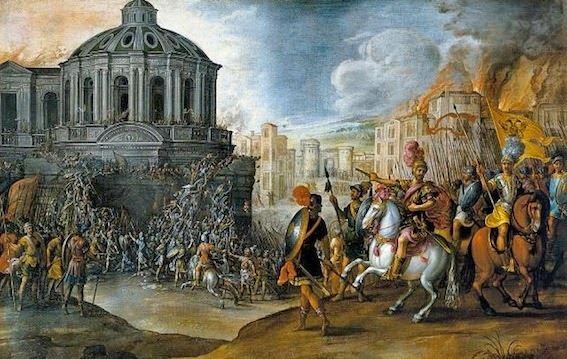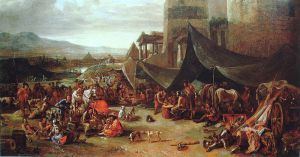20,000+ Spanish mercenaries 189 Papal Swiss Guards | Date 6 May 1527 | |
 | ||
Result Habsburg victory; escape of Pope Clement VII Similar Sack of Rome, Battle for Castle Itter, War of the League of Cognac, Battle of Shiroyama, Battle of Rorke's Drift | ||
The Stand of the Swiss Guard took place during the sacking of Rome on May 6, 1527, when the Pope's Swiss guards held off troops loyal to the Habsburgs long enough for Pope Clement to escape.
Contents

Stand of the swiss guard
Context

The Vatican and the Papal States were part of the faction that opposed the Habsburg dynasty in the 1520s, an opposition that led to war when Pope Clement VII appealed to France for aid.

The Habsburg army, composed of Imperial and Spanish troops, was placed under the command of the Constable of France, the Duc de Bourbon, fallen from grace in France and now serving the enemy. The constable's army, with a large contingent of Lutheran mercenaries, had become increasingly mutinous, and the Emperor was preoccupied with other matters, making him unable to pay them.

As a result of his troops' attitudes, Bourbon decided to attack Rome, known to be filled with potential loot. The city, considered to be the inviolable capital of Christendom, was left almost defenseless, and, when the Pope anxiously ordered the citizens to take up arms, only 500 obeyed. Bourbon's troops quickly overwhelmed the defenders and began to plunder the ancient city. Near St. Peter's Basilica, the Swiss Guard, as the Pope's elite bodyguard unit, deployed. The captain, Kaspar Röist, intended to hold off the attackers long enough for Clement to escape across the Passetto di Borgo.
After the city's sack and the Guards' stand, Rome was subjected to a brief occupation, during which Catholic and Lutheran German troops committed outrages against the population and its religious monuments. Pope Clement, from his nominal confinement in the Castel St. Angelo, was forced to listen to cries of "Long live Luther, pontiff!" The Pope was allowed to incorporate the surviving Swiss into his new, Habsburg-authorized guard, but the Swiss Guard was reinstalled in its entirety after the occupation.
Battle
Joined by remnants of the Roman garrison, the Swiss made their stand in a cemetery well within the Vatican. Captain Röist was wounded and then killed by Spanish mercenaries, in full view of his wife. The Swiss fought bitterly, but were immensely outnumbered and almost annihilated. Some survivors, accompanied by a band of refugees, fell back to the Basilica steps. Those who went toward the Basilica were massacred, and just above forty survived. This group of forty, under the command of Hercules Goldli, managed to stave off the Habsburg troops pursuing the Pope's entourage as it made its way across the Passetto to the Castel Sant'Angelo.
In popular culture
Swedish power metal band Sabaton made a song about the stand, titled the Last Stand, from its album titled The Last Stand.
